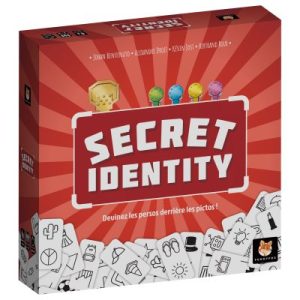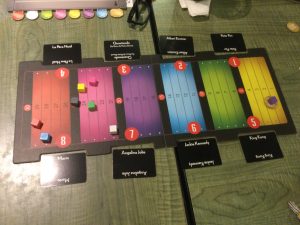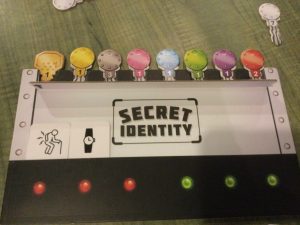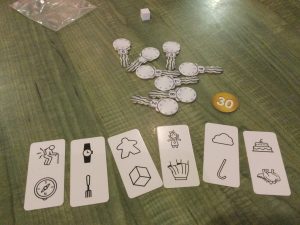| Publisher | Funnyfox |
| Design Credits | Johan Benvenuto, Alexandre Droit, Kévin Jost, Bertrand Roux |
| Art, Graphics Credits | Alain Boyer, Eliott Riva |
| Editing, Translation Credits | Lis Díez Bourgoin, Jacob Coon (Board Game Circus) |
| Game Contents | Eight safes/player boards, 64 Voting keys in eight player colors, eight Mystery keys, eight colored scoring markers, eight 30 scoring tokens, 90 Picto cards with four illustrations each, 150 double-sided Character cards, scoreboard, rules |
| Guidelines | Hidden-identity guessing game with graphical clues |
| MSRP | $24 |
| Reviewer | Andy Vetromile |
Given the dearth of phone booths these days, if you sport a secret identity you might want to find a new way to switch from skivvies to your “working” uniform. Then again, if your friends are clueless maybe you could just play Secret Identity from Funnyfox and your secret remains safe from prying eyes.
Not that you’d want it to be; the objective here is to get as many people to correctly guess who you are as possible.
Three to eight undercover individuals are given a board, a set of numbered keys, and a marker for the scoreboard in the middle of the table. They also receive a set of 10 Pictos, tiny cards that show four small pictures, one on either end on both sides. Running along the sides of the board are eight random Character cards displaying a name from history, legend, popular culture, and so on (Marie Curie, Meryl Streep, Batman, Coco Chanel…), each set next to a number.
Eight Mystery keys (not to be confused with the keys one receives as a player) determine which identity is yours for the round – if you get passed key 3, you’re assigned to personage #3 and the token is inserted into a special slot in your player slate. Using one to three of the Pictos you then try to hint who you are. There are plenty to choose from at first but once used they’re gone at round’s end; those 10 cards must last four rounds and thus be spent wisely. Two areas show the cards: red spaces and green spaces. Pictos on the green space mean that illustration (hopefully) shows something strongly associated with that identity like a dragon graphic if you want opponents to understand you’re Godzilla. Stuff placed in the red indicate it isn’t characteristic and maybe friends should go the opposite direction – if you’re Batman you could install a Picto of a woman there.
Once everyone has their pictures in place they’re shown to everyone and the guessing begins. Using the numbered keys in your player color you pass those to the others to indicate your guess and they do the same for you. Should the clues suggest Eric is really #7: Santa Claus, you pass him key number 7 and he sticks it into a slot in his “safe” next to his Mystery key. When all guesses have been doled out, players go around the table revealing their Secret Identity – and how many people got it right. They explain, if they feel the need, their thinking when using those particular Pictos and the other players congratulate them for their laser-like insight or berate them for their thin, sophomoric lack of vision, as appropriate. For every correct answer the proud player gets a point, and each correct guesser earns one point for themselves, tracked on the scoreboard.
After four rounds the high score wins; should there be a tie victory goes to whoever has the most Pictos still in hand (doing more with less is commendable).
When speaking of top-notch components, Secret Identity is the game you’re talking about. Everything here hits without quite going over the edge into “overproduced.” About the only thing you don’t really need are the “30” tokens – the scoreboard only goes that high and these indicate you’ve “wrapped around” back to the beginning of the track, something few people are liable to forget. The numbered “bands” on the board could be a little wider to better accommodate the score markers but only because they pretty much exactly fit them now; bump the table and it’s trouble. There are numbered slots cut into the track for the Character cards to sit in but they don’t really “hold” the IDs so it might have been better (cheaper?) to simply print the numbers on the sides rather than die-cut the scoreboard. The rules have been flawlessly translated from the original French (in the on-line .pdf – so far the game is only readily available across The Pond and some bits still employ the language of love like the Santa Claus card labeled as Père Noël).
The player boards, called safes, are the best part. They have a pocket where the Pictos are put (though, at least in a brand-new copy, they are really tight and sliding the cards in is tough if you’re worried about damaging them), and a (perhaps magnetic) flip-down panel that hides the keys and their numbers until you’re ready for the big reveal. Then it can be dropped and all the tokens are neatly lined up and ready for accounting. The identity cards are pretty good though the text could be a little larger – it doesn’t take up that much room in the space provided, and bigger is better when eight players are jostling for proximity to the table. And the Pictos? Well, those are simply adorable, and adorably simple in their graphic presentations. Most are obvious as to what they are but there’s always room for someone to make creative use of them or to find a clever way to completely misinterpret them.
Don’t blame folks too much if they can’t follow through, though. There’s some eyestrain involved, looking from your keys to other players’ boards and back again. You need to see their Pictos (which often involves asking repeatedly to see their safe a bit closer) and then decide which token to give them as your Secret Identity guess and that can be hard to do if they’re at the other end of a table for eight. You can play with as few as three but it does seem like one of those “more the merrier” situations; participants have to find the player balance that works for them. Distributing keys is a distraction as well – you can pass them out as you decide who you think is whom, but if you change your mind you have to start asking for keys back. One might instead arrange the keys in some secretive order face-down on the table in front of themselves and then pass them all out at once but if you forget to whom you assigned something or you rethink what their clues suggest, it involves much flipping back over of facedown keys to recheck your progress. They’re solid cardboard items but can be tough to pick up and flip given they’re skinny on one end. Keeping them in your hand isn’t much of a solution. In short, it can be a fiddly process and a lot to take in.
That’s not going to stop anyone, though, since passing out keys is the, uh . . . key. . . to the game. If you’re playing Secret Identity you can’t help but discover yourself deep in it and even spectators find it’s hard not to watch (and wish you were playing). The flip-flops and gyrations your mind performs trying to figure out who’s who keep you on your toes beginning to end. Just as you think you have most everyone nailed down you discover there’s another interpretation of the clues you hadn’t considered – even if it’s just for one player, that change can throw everyone else’s carefully worked-out persona into a cocked hat. The frustration is exquisite. Secret Identity admittedly borrows a lot from recent guessing-game releases mounting in the marketplace like Mystic Paths and Decrypto et al, but that said this is its own animal – has its own identity, one might say – and makes its mark as an admirable entry in the field.



